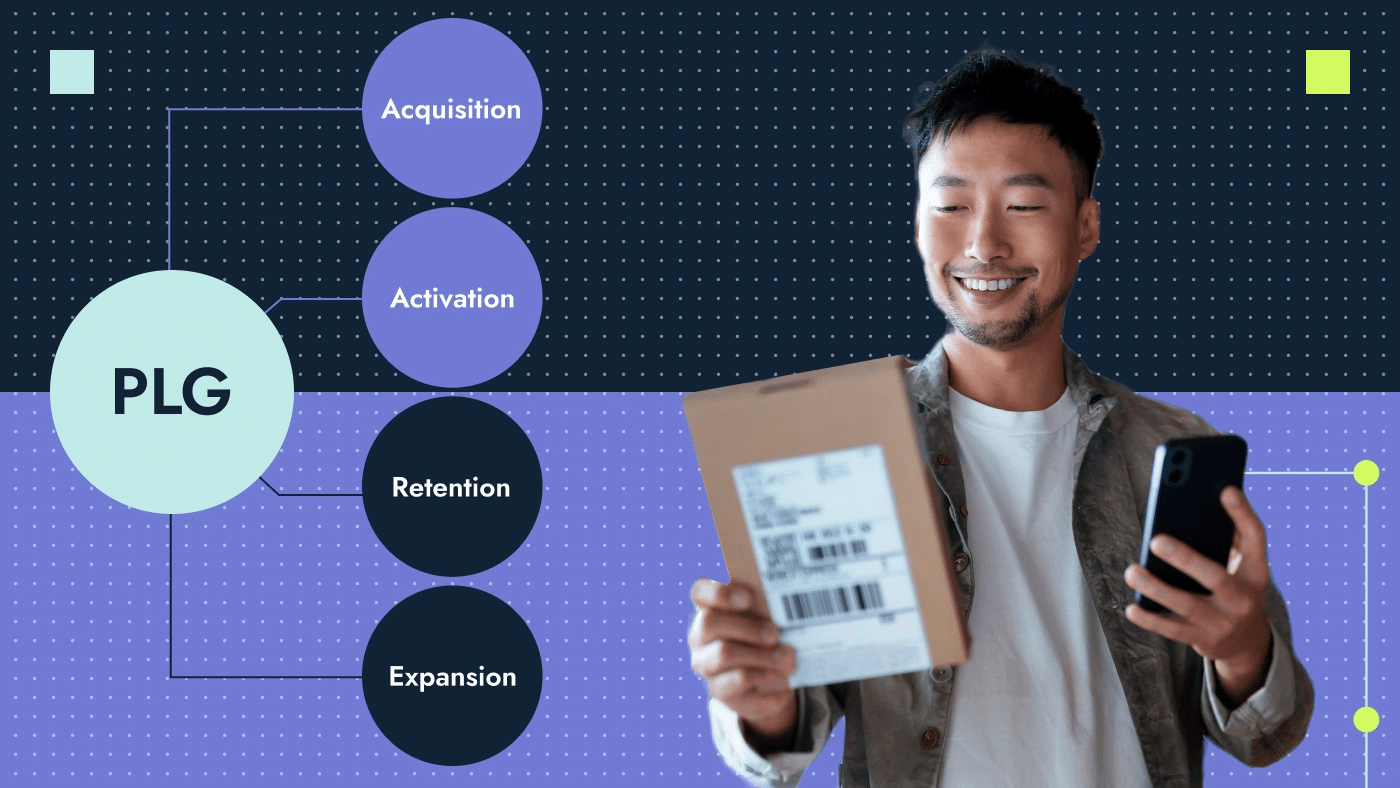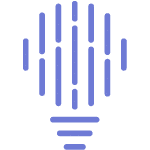Product led growth: The secret to B2B SaaS success?

In the fast-paced software as a service (SaaS) industry, companies continually search for innovative strategies to drive growth and stay ahead of the competition. In recent years, one such strategy that has gained some traction is product led growth (PLG).
At its core, PLG is a business model prioritizing the product as the primary growth driver. The goal is to create a user experience so compelling that people are motivated to buy the product and refer others. PLG companies encourage adoption and growth by allowing customers to try the product for free and hope they like it enough to upgrade to the paid plan.
You’re probably rolling your eyes right now, thinking, “Get customers by creating a great product? Thanks a lot, Captain Obvious!” However, despite its apparent simplicity, the product led growth model is complex and requires careful implementation.
So what exactly does it take for a company to embrace PLG? Are there any potential drawbacks to this approach, or is it all sunshine?
In the following sections, we’ll explore product led growth, ways to engage in it and challenges companies may face.
What is product led growth?
Product led growth is a go-to-market strategy that centers on the product to drive customer acquisition and retention.
Consequently, the first requirement of PLG is creating a product that is intuitive, easy to use and solves a real problem for the end-user. Once the product is developed, the focus shifts to distribution through free trials and freemium models.
Having established a user base, gathering data and feedback is vital to guide further development. The success of PLG ultimately depends on getting users to try the product and ensuring they have a great experience using it.
According to a Gainsight survey, a PLG strategy already exists in 58% of companies and 47% planned on doubling their investment.
The history of product led SaaS growth
You can trace the roots of PLG back to the early days of the internet and the rise of software as a service. SaaS companies offered a new way of delivering software products to businesses and consumers via the internet. Over time, these companies realized that their products could also be used as powerful tools for driving growth and customer acquisition.
Initially, most software companies relied on sales led growth (SLG). SLG is effective for selling complex and expensive enterprise software solutions but has several drawbacks. SLG requires a lot of upfront investment in sales and B2B marketing and creates a long and cumbersome sales cycle, often resulting in low customer satisfaction and high churn rates. The typical example of SLG sales is enterprise resource management (ERP) systems or supply chain management (SCM) software, which require a large SDR, BDR and AE team to sell.
The rise of cloud computing, software as a service and freemium models enabled software companies to offer their products directly to customers online without intermediaries or any upfront commitments. At the same time, this lowered the barriers to entry and increased the competition in the market, forcing SaaS companies to differentiate themselves by offering superior and unique solutions.
Finally, PLG emerged as an alternative to SLG, inspired by the success of companies like Salesforce, Dropbox and Shopify. These companies built products that were easy to use, delivered value quickly and encouraged viral adoption through word-of-mouth and referrals.
Instead of relying on sales teams to convince customers to buy their products, they let their products speak for themselves. They offered free trials or freemium models that allowed customers to try before they bought and optimized the products for self-service and user feedback.
The term “product led growth” was coined by OpenView Venture Partners, a Boston-based VC firm that observed this significant shift in how SaaS companies approached growth. According to OpenView, the median enterprise value (EV) of PLG companies is now twice the public SaaS index.
How is PLG in SaaS different from other models?
In traditional models, companies rely on sales and marketing teams to drive revenue by proactively reaching out to potential customers, generating traffic and finding prospects. This approach often involves a high-touch sales process, with sales representatives conducting product demos and engaging in negotiations to close deals.
It’s worth noting that these methods are not mutually exclusive, and many companies use a combination of tactics to drive growth. However, understanding the strengths and weaknesses of each approach can help you identify the most effective strategy for your particular business and goals.
Here’s how PLG compares with other B2B SaaS go-to-market strategies:
Product led growth vs customer led growth
Customer led growth (CLG) relies heavily on customer success, loyalty and advocacy to increase retention and expansion. CLG businesses often use surveys (they’re obsessed with their net promoter score), interviews and customer-facing roadmaps to understand and meet customer expectations.
One of the primary benefits of CLG is that it enables businesses to build strong customer relationships that can help drive growth in the long term. CLG can, however, be more resource-intensive than PLG. By prioritizing customer engagement, businesses may need to invest more in research software, customer support and customer success teams.
Often, SaaS companies will use a combination of product and customer led growth. They first focus on creating a killer product through PLG and then make improvements based on customer feedback and sentiment.
Product led growth vs marketing led growth
Marketing led growth (MLG) is a strategy that prioritizes marketing and advertising as the primary driver of growth. By investing in targeted campaigns, businesses can raise brand awareness, generate leads and ultimately drive sales.
Tech media company The New Stack, for example, focuses on marketing led growth via a steady stream of high-quality articles, podcasts, videos and newsletters tailored to a DevOps audience. Many e-commerce retailers, such as Incase and Yugenite, leverage their websites and social media channels to showcase their products, features, benefits and stories. They also collaborate with influencers and events to create buzz and awareness around their brand.
MLG can deliver immediate results, especially in industries with intense competition for customer attention. This strategy is also suitable for complex and expensive products that require more explanation and trust-building before purchase. The downside of marketing-led growth is that it can be resource-intensive and will only retain customers if there is a solid product to back it up.
MLG relies on omnichannel campaigns to be successful, and understanding the market determines which channels to invest in more:
- Paid advertising
- Search engine optimization
- Newsletters
- Social media
- Press releases
Companies may benefit from a hybrid approach combining PLG and MLG elements. For example, a company may use PLG to acquire and activate users through a free trial or a freemium model and then use MLG to upsell and cross-sell them to higher-tier plans or additional features.
Product led growth vs sales led growth
Sales led growth (SLG) is a model where the sales team is the main driver of customer acquisition, retention and expansion. Scaling and growth are achieved by hiring more salespeople and optimizing the sales process. SLG is more suitable for products with a high entry barrier (like enterprise accounting software or enterprise cybersecurity software), low virality and low customer satisfaction.
SLG products also tend to have a top-down adoption process, where decision-makers buy the product and then mandate the users or teams to use it.
The main advantage of SLG is that it can increase the revenue potential and control companies have over customer behavior and preferences. SLG companies often have a high average revenue per user (ARPU), as they charge premium prices for their complex and customized solutions.
However, SLG also increases the customer acquisition cost (CAC), and customers are more likely to switch to a cheaper alternative if and when it becomes available. According to another report by OpenView, PLG companies are twice as likely to experience year-over-year revenue growth than SLG companies.
Choosing between PLG and SLG requires a careful analysis of your product and sales capabilities. In a hybrid model, companies can create a seamless transition from PLG to SLG when needed. For example, customers who start with a free trial or freemium can be contacted by a sales representative when they show signs of interest or engagement with the product.
A comparison of the growth models
| Growth strategy | Characteristics | Key metrics to track | Advantages | Disadvantages |
|---|---|---|---|---|
| Product led growth | Emphasizes the importance of building a product that is inherently valuable, easy to use and promotes user adoption. Leverages free trials, freemium models and referrals to drive growth. | Activation rates Retention rates Product virality | Lower customer acquisition costs Higher customer retention rates Ability to scale quickly and efficiently | Requires a high-quality product to be effective. Is not suitable for all products and industries. |
| Customer led growth | Prioritizes understanding and meeting the needs of customers. Seeks to build a loyal customer base through excellent customer service and personalized experiences. | Customer satisfaction scores Net promoter score (NPS) Customer lifetime value | Strong customer relationships and loyalty Revenue generation through word-of-mouth marketing | May be slower to generate growth than other approaches. Requires investment into customer support. |
| Marketing led growth | Focuses on building brand awareness and generating demand through targeted marketing campaigns. Relies on a deep understanding of the target market and audience. | Traffic and conversion rates Marketing return on investment (ROI) | Opportunity to build lasting brand identity and reputation Lower customer acquisition costs than sales led growth | Needs significant marketing investment. Measuring ROI can be harder than other approaches. Can be ineffective due to high competition and saturation in crowded markets. |
| Sales led growth | Relies on traditional sales tactics to maximize revenue. Emphasizes closing deals rather than long-term customer relationships. | Sales revenue Sales pipeline velocity Average deal size | Predictable and quick revenue generation Clear ROI on sales expenses Easy scaling by adding more sales team members | Has high customer acquisition costs. Can experience lower customer retention rates due to a focus on short-term revenue. |
The product led growth model: A high-level overview

The PLG sales model is built on a self-serve approach, which means customers try the product for free or at a low cost and then upgrade to a paid version if they find it valuable. This approach creates a low-pressure, low-risk environment for users to test the product on their own terms before making a purchasing decision based on their experience.
The product led growth model consists of the following key components:
1. Acquisition
Attracting and converting potential customers to your product is crucial, and the key is to offer a frictionless, high-value way for people to try it out. This could be through a free trial, a freemium model or a self-service option.
You’ll also want to optimize your website, landing pages and app store listings to clearly and persuasively communicate your value proposition to visitors. Boost your customer acquisition efforts and get more traffic by combining organic channels — such as SEO and content marketing — with paid ads and affiliate marketing.
2. Activation
The second step involves turning your trial users into active and engaged users. You want these users to experience the core value of your product and be compelled to upgrade their free plan. As they become paid users, you should aim to provide a smooth and intuitive onboarding experience that guides customers to achieve their desired outcomes with your product.
You must also collect feedback, measure/analyze user behavior and identify the key actions or events (feature adoption, aha moments or milestones reached) that correlate with user activation. User behavior can be measured with various PLG software/tools:
- Chameleon: A platform that enables product teams to create personalized in-app experiences, such as tours, banners, modals and surveys, to guide users to success. Chameleon also provides analytics and feedback features to measure user behavior and satisfaction.
- Userpilot: A tool that helps product teams deliver engaging product experiences, such as onboarding flows, feature announcements and NPS surveys. Userpilot also offers insights and segmentation features to track user behavior and target users with the right messages.
- Pendo: A product cloud that provides a comprehensive suite of features to help product teams understand and improve user behavior, such as analytics, feedback, guidance and experimentation. Pendo also integrates with other martech platforms to create a unified view of the user journey.
3. Retention
Retention means keeping your active users loyal and happy with your product. The key is to build these long-term user relationships and try to maximize their lifetime value to your business. User satisfaction is achieved through consistent value delivery, solving pain points and delighting users with value-added features and services.
Additionally, you should nurture user relationships, provide proactive support and encourage user feedback. Several web platforms allow you to create a community, provide support and get feedback. Here are some of our recommendations:
- Zendesk: A cloud-based customer service software that enables you to provide support to customers via phone, email and web chat. It also includes a self-service help center, ticketing system and knowledge base and integrates with other applications such as Salesforce, Twitter and Facebook.
- Intercom: A customer engagement platform that helps companies communicate with their customers. It provides a way for customers to communicate with a company directly through email, web chat and social media. It also offers tools to help businesses manage customer relationships, track customer engagement and can be used to create automated messaging campaigns.
4. Expansion
The last step involves growing your revenue and reach with upselling, cross-selling and referrals. You can leverage your existing user base as a source of growth by offering them premium plans, add-ons and complementary products. You must also incentivize user referrals, testimonials and case studies and encourage social proof and word-of-mouth marketing.
For product led growth in B2B, employee advocacy on social media platforms, such as LinkedIn, can be an excellent way to spread your message. Also, social proof is huge. According to Bazaarvoice, user engagement with on-site reviews led to a 144% increase in conversion rates. Here are some online tools to encourage user reviews on your website:
- Bazaarvoice: A solution provider for collecting and displaying customer-generated content such as reviews, ratings, questions and answers and testimonials. The platform allows companies to create and manage campaigns, grow their online presence and build meaningful customer relationships.
- Trustpilot: A customer review platform that helps businesses build trust and transparency with their customers. It allows customers to share their experiences with a business and rate it on a scale of 1-5 stars. Businesses can use Trustpilot to respond to customer feedback and improve their reputation.
The product-led growth strategy is not a one-size-fits-all approach. It requires a deep understanding of your target market, product value proposition and buyer journey. It also requires a culture of experimentation, iteration and collaboration across different teams and functions. However, when done right, it can help you build a scalable, sustainable and profitable business that thrives on user love.
Examples of product led growth companies
Here are a few examples of successful PLG companies that have made a name for themselves in the SaaS industry:
- Dropbox: One of the earliest and most successful PLG companies. They introduced the freemium model, offering a free version of their product with limited storage, and encouraged people to try it out and upgrade to paid plans. Dropbox also incentivizes users to invite friends and contacts by offering them free storage for each referral and partners with other platforms to increase the utility and convenience of their software.
- Slack: Another PLG success story that has revolutionized how teams communicate and collaborate. Users can invite other members to join their workspace, creating a viral loop that increases Slack’s exposure and adoption. Slack also integrates with hundreds of other apps and tools that users already use, such as Google Drive, Salesforce and Zoom.
- Unit: A banking-as-a-service business that allows you to add financial features and services to your platform. Unit obsesses over constant product improvement and adding new features, such as white-label user interfaces (UIs), enabling customers to reach a faster time-to-market. The company also prioritizes customer experience to stand out in the market, with customer feedback guiding their product roadmap decisions.
- LearnWorlds: A product led growth company revolutionizing how users create, manage and deliver their online products and training. The goal is to help these users monetize their experience and skills, and the platform acts as a catalyst for learning and personal growth. Thanks to an excellent product and constant updates with product release notes, LearnWorlds has seen rapid growth and has been widely embraced by its community. Referrals and word-of-mouth, signs of a successful PLG strategy, were a big part of how they achieved such massive exposure.
LearnWorlds may have had a little help growing online visibility, though. Read our case study.
What are the benefits of product led growth?
Let’s look at some key advantages of PLG and how it can help you grow faster.
Lower customer acquisition cost (CAC)
According to Latka, SaaS companies spend, on average, between $0.28 and $0.94 for each dollar of new recurring revenue. If their product costs $1,000, they pay between $280-$940 to acquire that customer.
One of the main benefits of PLG is that it can significantly lower your customer acquisition cost (CAC), which is the amount of money you spend to acquire a new customer. By offering a free trial, a freemium model or a self-service option, you can let your product do the selling for you and reduce the need for expensive sales and marketing campaigns.
You can also leverage word-of-mouth and referrals from your existing users to drive organic growth and increase your brand awareness.
Better user value and customer lifetime value
Another benefit of PLG is that it can improve your user value and customer lifetime value (LTV), which are measures of how much value your users get from your product and how much revenue they generate for your business over time.
By focusing on delivering a product that solves a real problem for your users and provides them with a great user experience, you can increase their satisfaction, loyalty and retention. You also get the opportunity to upsell and cross-sell them to higher-value plans or features.
Faster feedback and iteration cycles
PLG can enable faster feedback and iteration cycles for your product development. By allowing your users to try and use your product directly, you can collect valuable data and insights on their behavior, preferences, pain points and feedback. You can then use this information to optimize your product features, design, performance and usability based on what your users actually want and need. You can also test and validate your hypotheses and assumptions quickly and efficiently using experiments and analytics.
Efficient and cost-effective scaling
PLG companies can scale their business more efficiently and cost-effectively by using their product as a growth engine. In building a product that can serve a large number of users with minimal human intervention, you reduce your operational costs and increase profit margins.
You can also leverage network effects and virality to grow your user base exponentially without spending much on marketing. PLG businesses can extend their market reach to different segments and geographies with minimal customization or localization.
Improved product-market fit and expansion
By aligning your product vision with your user needs and expectations, you can create a product that delivers real value for your target market and solves specific problems. You can also leverage your user feedback and data to identify new use cases, features or markets you can tap into with your product. This approach allows your product to adapt to customer demands and new trends in the industry.
How to achieve product led growth

According to a Product-Led Growth Collective report, PLG companies have a 29% higher median revenue multiple than non-PLG companies. But how can a company embrace PLG and transform its culture, processes and metrics to become more product-centric? Here are some steps and tips for implementing a PLG strategy and building a product led organization:
1. Align your organization around the product led growth strategy
PLG is not just a product strategy but a company-wide mindset that puts the user at the center of everything you do. This means that everyone in your company, from the leadership to the frontline employees, should understand what PLG is, why it matters and how it impacts their roles and responsibilities.
One way to create this alignment is to define and communicate your PLG vision and goals. What are you trying to achieve with PLG? How do you measure success? How do you track progress? How do you reward and incentivize your teams? Everyone in the organization should know the answers to these questions.
Another way to create alignment is to foster a culture of collaboration and cross-functional teamwork. PLG requires close coordination and communication between teams, such as product, engineering, marketing, sales, customer success and support.
PLG companies also need to be willing to invest in technology and tools that support their PLG strategy. This includes investing in analytics software, customer feedback tools and marketing automation platforms that can help streamline user acquisition and retention efforts.
2. Define your ideal customer profile (ICP) and value proposition
Before you can design a product that delivers value to your users, you need to know who they are, what they need and how to solve their problems. Your ICP is the type of customer most likely to benefit from your product, while your value proposition is the main benefit or outcome your product delivers to your customers.
A clear ICP and value proposition will help you target the right audience, communicate your unique benefits and align your product development with your market fit.
To define your ICP and value proposition, you should conduct extensive user research and analysis. You should also validate your assumptions by testing your product with real users and collecting feedback. The success of your product will depend on how well it solves their problems, how much value they perceive from using it, and how satisfied they are with it.
→ Free download: ICP template for startups
3. Create a self-serve product
A self-serve product allows users to sign up, use and buy without requiring human intervention or assistance, enabling them to explore the product at their own pace and convenience.
Creating a self-serve product is essential for PLG because it lowers the barriers to entry for potential customers and provides them with immediate value and gratification. It also reduces the dependency on salespeople and increases the efficiency of the sales process.
To create a self-serve product, consider the following aspects:
- Pricing: You should offer a free or low-cost option allowing users to try your product without risk or commitment. It is also important to provide clear and transparent pricing information that explains what each plan or tier includes.
- Onboarding: You should provide a smooth and intuitive onboarding process that guides users through your product’s key features and benefits. Provide users with videos, tips, tutorials, or other resources that will help them use your product effectively.
- Activation: You should define and track the key actions or milestones that indicate that users are getting value from your product. Encourage users to upgrade to more advanced features if they show signs of engagement with the free version.
4. Use data and feedback to optimize for user experience
The final step is to use data and feedback to continuously monitor and improve your product performance and user experience. You should collect and analyze both quantitative and qualitative data from various sources, such as analytics tools, surveys, reviews and interviews, to understand how users interact with your product, what they like and dislike about it, what challenges they face and what outcomes they achieve.
Using this information to optimize user experience, you can identify and fix any product functionality or design gaps that might hinder user satisfaction and retention. You can also discover new opportunities or ideas for expanding your product features and value proposition that increase user engagement or loyalty.
Product led growth metrics to track
How do you know if your product led growth strategy is working? How do you measure the impact of your product on your business goals? That’s where metrics come in. Here are the ones you need to keep an eye on:
- Time to value (TTV): This is the time it takes for a user to experience the core value proposition of your product. It measures how quickly and easily your product delivers value to your customers. The shorter the TTV, the more likely your users will stick around and become loyal customers. You can measure TTV by tracking the key actions or events that indicate value delivery, such as completing a task or achieving a goal.
- The formula: ƒ count (time between first user action and initial value realization)
- Expansion revenue: This metric measures the revenue generated from existing customers who upgrade their plans, buy additional features or refer new users. Measure expansion revenue by tracking feature adoption rates, which are the percentages of users who use a specific feature or function. For growth, Price Intelligently recommends that at least 30% of your total revenue come from expansion revenue.
- The formula: Expansion monthly recurring revenue (MRR)= Total monthly revenue from cross-sells + total monthly revenue from upsells
- Alternate formula: Expansion revenue = total revenue – revenue generated from new customers and their subscriptions
- Product qualified leads (PQLs): These leads have shown high interest and engagement with your product based on their behavior and usage data. They are more likely to convert into paying customers than traditional leads who are qualified by sales or marketing criteria. You can measure PQLs by tracking the activation rate, which is the percentage of users who complete a predefined set of actions that indicate readiness to buy.
- Retention rate: This metric is the percentage of users who continue to use your product over a given period of time. It measures how well your product retains and engages your customers and how sticky and valuable your product is.
-
- The formula: Retention rate = (number of paying users at the end of time period/total number of paying users at the beginning of time period) x 100
- Net promoter score: A score that measures how likely your users are to recommend your product to others, how happy and satisfied your customers are with your product and how loyal and enthusiastic they are. You can measure NPS by asking your users the simple question “how likely are you to recommend our product to a friend or colleague?” and giving them a scale from 0 (not at all likely) to 10 (extremely likely).
-
- The formula: NPS = (percentage of promoters – percentage of detractors)
- Product virality: This is the degree to which your product spreads organically through word-of-mouth or social media and how well your product acquires new users without spending on marketing or advertising. You can measure product virality by tracking the viral coefficient, which is the number of new users acquired by each existing user through referrals or invitations.
-
- The formula: C(0) * k = number of customers at end of time period
- (C(0) = number of customers at the beginning of time period, k= number of new customers converted by existing customers)
4 popular product led growth frameworks
Many frameworks already exist that can help PLG companies design and optimize their products for growth. Here are the four most popular ones:
1. Growth loops
A growth loop is a chain of actions that users take with a product that generates more users or revenue for the product. Growth loops can be classified into three types:
- Viral loops: Focused on acquiring new users through referrals or word-of-mouth.
- Engagement loops: Focused on retaining and activating existing users through feedback or rewards. The Netflix recommendation engine is an example of an engagement loop.
- Monetization loops: Focused on increasing revenue from existing users through upselling or cross-selling.
To create effective growth loops, PLG companies need to identify the key actions that drive value for their users and their product and measure the performance of each loop using metrics such as loop speed, loop conversion rate and loop amplification factor.
2. The hook model
The hook model is a framework that describes how products create habit-forming behaviors in users. The model helps PLG companies design products that keep users coming back by creating a cycle of four stages:
- Trigger: A cue that prompts the user to take an action with the product. A trigger can be external (such as a notification or an email) or internal (such as a need or an emotion).
- Action: A simple and easy behavior that the user performs with the product in response to the trigger. An action can be clicking a button, opening an app or typing a message.
- Reward: A positive outcome that the user receives from the action. A reward can be variable (such as a surprise or a novelty) or intrinsic (such as a sense of accomplishment or belonging).
- Investment: An effort that the user puts into the product that increases the value of the product and the likelihood of future actions. An investment can be adding content, personalizing settings or inviting friends.
3. Fogg behavior model
By increasing the motivation and ability of users, the Fogg behavior model encourages them to perform desired behaviors. The framework is based on the premise that these three factors influence human behavior:
- Motivation: The desire or willingness to do a behavior. Motivation can be driven by pleasure or pain, hope or fear, social acceptance or rejection.
- Ability: The ease with which a behavior can be performed. Ability can be affected by time, money, effort or non-routine.
- Prompt: A signal or reminder to do a behavior. A prompt can be internal (such as an intention or a habit) or external (such as a notification or a call to action).
📚 History drop: This model was developed by Dr. BJ Fogg, a behavioral scientist and director of the Behavior Design Lab at Stanford University. It has been applied to various domains such as health, education, finance, sustainability and social media.
4. RICE prioritization model
The RICE prioritization model helps PLG companies make data-driven decisions about what to work on next by scoring each feature or initiative based on four criteria and comparing them with each other. The criteria are:
- Reach: The number of users or customers who will benefit from the feature or project.
- Impact: The degree of improvement or changes the feature or project will create for the users or customers.
- Confidence: The certainty level or evidence supporting the estimated reach and impact.
- Effort: The time or resources required to complete the feature or project.
The challenges and drawbacks of product led SaaS growth
As great as it sounds, product led growth is not for everybody. Here is the set of challenges and drawbacks that need to be carefully considered before embarking on the PLG journey:
- Product complexity and feature bloat: As the product evolves to meet the needs and expectations of different user segments and personas, it can become more difficult to use, maintain and scale. Adding more features can dilute the product’s core value proposition and make communicating and demonstrating to new users harder.
- Customer education: Unlike traditional sales led models, where sales reps can guide prospects through the buying journey and address their questions and objections, PLG relies on the product to educate and persuade users. SaaS companies must provide other resources and channels to help users learn more about their product and how to use it effectively. This can include blogs, webinars, podcasts, ebooks and case studies.
- Friction between sales and product teams: In some cases, PLG can create a conflict between the goals and incentives of these two teams. For example, the sales team may want to push for more demos, trials and discounts to close deals faster, while product teams may want to focus on improving the product quality, usability and value.
- End-users do not have a say in the B2B buying decision: In many B2B scenarios, the end-users who use the product are not the same as the decision-makers who approve the purchase. This means that product led growth in B2B needs to convince not only the end-users who love their product but also the stakeholders who control the budget and authority.
- Market conditions must be right: PLG works best when there is a large and growing market demand for the product category, low or no switching cost for users to try new products, a high network effect or virality potential for the product usage or sharing and low or no regulation or compliance barriers for the product adoption. If these conditions are unmet, PLG may not be the most effective or suitable strategy for SaaS companies.
Productive Shop: Your B2B product led growth partner
If you follow the approaches outlined in this guide and focus on creating a great product and constantly improving it, you will see significant results. Your user base will grow naturally through referrals, and you can set up communication channels to add more features that your customers need. But sometimes, product led SaaS growth needs a bit more than that.
A great product is the first requirement, but what if your website isn’t optimized to funnel leads toward a demo or free trial? What if your product requires extensive customer education before prospects can have that “aha” moment? Do you want to wait for word-of-mouth to take your business to the next level and miss out on the immediate results of SEO marketing?
As a growth marketing consultancy, Productive Shop helps product led SaaS businesses to generate more leads, increase signups and dominate share of voice. Working with us is like having a seasoned sherpa guide you up a mountain; we know the terrain, the route to the summit and how to navigate the treacherous pitfalls along the way.
Get in touch to ensure a safe and successful climb to the top.

Productive Shop Team
With diverse backgrounds and a shared enthusiasm for innovation and growth strategies, our passionate team of consultants brings together a wealth of experience and skills to meet the marketing and lead generation needs of B2B SaaS startups. Our seasoned writers, SEO specialists, project managers, designers and developers are always eager to share their knowledge and drive thought-provoking conversations.



